|
MARIANI’S
Virtual Gourmet
January
27, 2008
NEWSLETTER
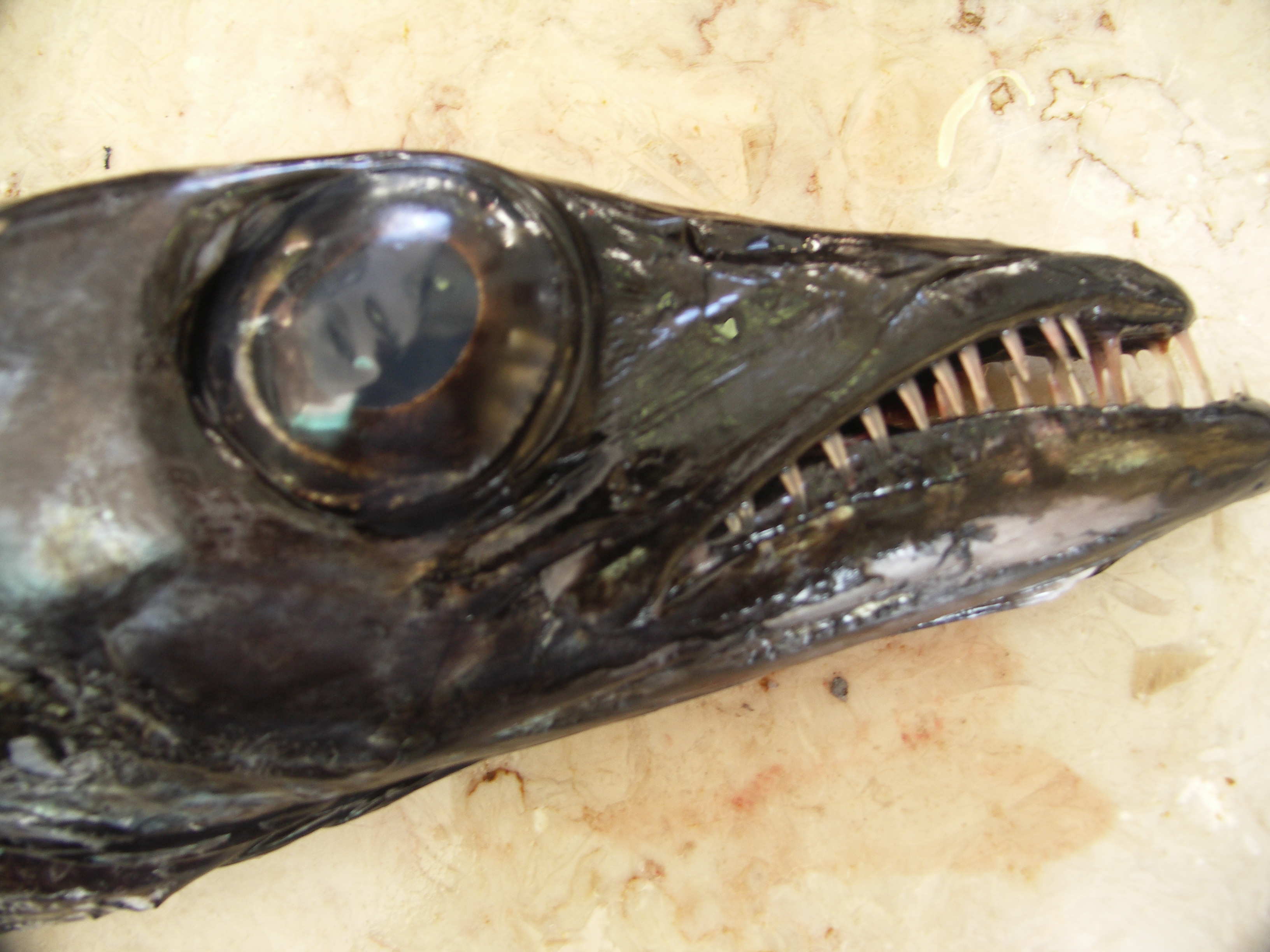 Espada
(barracuda) at
The Funchal Fish Market, Madeira, Portugal (2006), photo by Galina
Stepanoff-Dargery
Espada
(barracuda) at
The Funchal Fish Market, Madeira, Portugal (2006), photo by Galina
Stepanoff-Dargery
NEW! Click esquire.com
to go to my new column at Esquire Magazine.
ARCHIVE: Readers may now access
an
Archive of all past newsletters--each annotated--dating back to July,
2003, by simply clicking on www.johnmariani.com/archive
SUBSCRIBE AND
UN-SUBSCRIBE: You may subscribe anyone you wish
to this newsletter--free of charge--by
clicking here.
In
This Issue
EATING
OUT IN HONG KONG, PART TWO by John A. Curtas
NEW
YORK CORNER: Capsouto
Frères by Mort Hochstein
NOTES
FROM THE
WINE CELLAR: Meritage Celebrates 20th Anniversary with
201st Member by John Mariani
QUICK
BYTES
Eating
Out in Hong Kong, Part
Two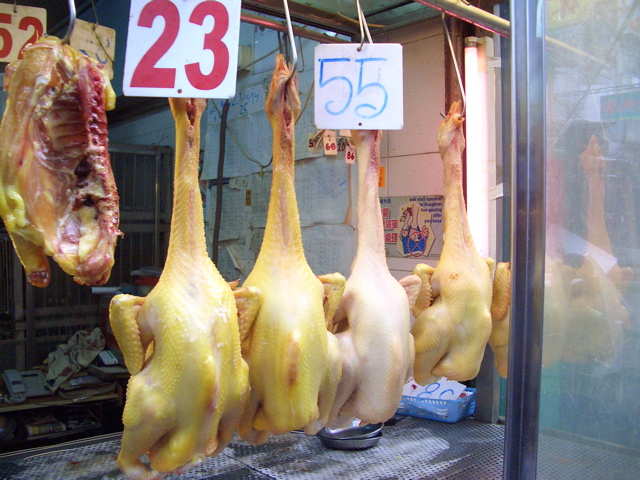
by John A. Curtas
Dinnertime
in Hong Kong presents but one main question to the avid
eater: old
school or new? The city resembles
nothing so much as an Asian New York crossed with Vegas; meaning the
Central
district is full of plush hotels and elevated mega-malls containing a
variety
of expensive dining options. There are
enough steakhouses (Morton’s, Ruth’s Chris, et al.), fusion factories (Nobu),
sparkling Italian joints (Da Domenico, Grissini) and celebrity chef
outposts
(L’Atelier, Spoon) to put any food xenophobe at ease.
But should you wish to dive into the deep end
of Cantonese cooking, there’s no better place to start than at the
venerable Yung Kee (32-40
Wellington Street; Central;
852 2522 1624; www.yungkee.com.hk).
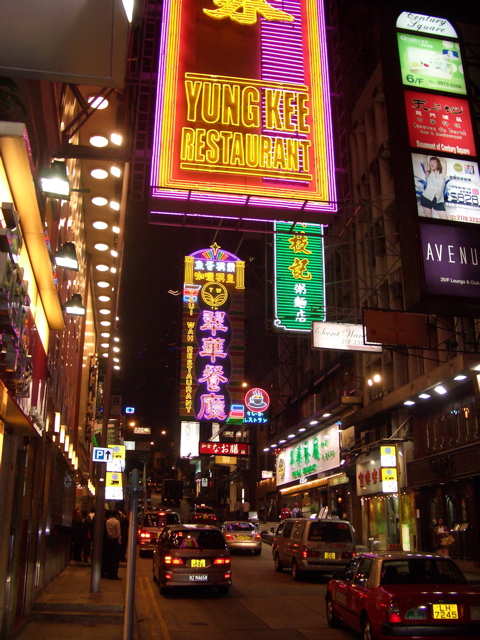 Yung
Kee has been celebrating the cult of the splayed goose since the
1950’s, and
there’s no doubt what to order once you pass the front window, where
chefs
slice, flatten and prepare them on thick round chopping blocks on their
way to
the roasting ovens. It is also famous
for the luminescent purple-green yolks and amber colored whites of its
1,000-year old eggs (below). These pungent,
sulfuric delicacies are really closer to 100 days old, having been
submersed in
lime, ashes and salt for about that long. Accompanied
by fresh pickled ginger, they clear the palate
and the head
for the rich and fatty goose yet to come.
Before
the main attraction came two seafood offerings; first a mixed seafood
soup with
bean curd that was as snow white as the rice flour noodles at
MiddleRow,
followed by deep fried prawns stuffed with crab roe.
The soup was subtle to the point of
insipidness, and benefited greatly from a healthy shake from the white
pepper
bottle. The stuffed shrimp were a surf-and-lake delight, wrapped in a
lighter-than-air
crust that tightly encased the crab fat and roe and as perfect as
fried
seafood can be. For the finale, a whole
breast of moist and savory roasted goose was served with a fresh plum
sauce
that put
the bottled stuff we Americans take for granted to shame. Yung
Kee has been celebrating the cult of the splayed goose since the
1950’s, and
there’s no doubt what to order once you pass the front window, where
chefs
slice, flatten and prepare them on thick round chopping blocks on their
way to
the roasting ovens. It is also famous
for the luminescent purple-green yolks and amber colored whites of its
1,000-year old eggs (below). These pungent,
sulfuric delicacies are really closer to 100 days old, having been
submersed in
lime, ashes and salt for about that long. Accompanied
by fresh pickled ginger, they clear the palate
and the head
for the rich and fatty goose yet to come.
Before
the main attraction came two seafood offerings; first a mixed seafood
soup with
bean curd that was as snow white as the rice flour noodles at
MiddleRow,
followed by deep fried prawns stuffed with crab roe.
The soup was subtle to the point of
insipidness, and benefited greatly from a healthy shake from the white
pepper
bottle. The stuffed shrimp were a surf-and-lake delight, wrapped in a
lighter-than-air
crust that tightly encased the crab fat and roe and as perfect as
fried
seafood can be. For the finale, a whole
breast of moist and savory roasted goose was served with a fresh plum
sauce
that put
the bottled stuff we Americans take for granted to shame.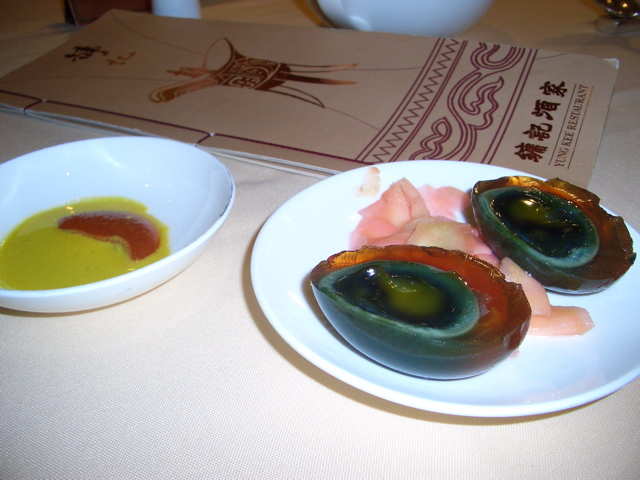 Descending
the four floors of this huge restaurant after the meal, I noticed there
wasn’t
a table left to be had, and I sneaked one last peak upon the chefs in
the
front
window. Big mistake. Because
standing there, beside a
cleaver-wielding chef, within inches of a chopping block, were the
knees and
shoes of a window washer, soaping the inside of the picture window. I can’t say that it ruined the otherwise
exquisite meal, but it did point up what a French chef friend of mind
told me
upon returning from cooking a banquet for high rollers in Guangzhou. With a
classic Gallic shrug, and inadvertently paraphrasing F. Scott
Fitzgerald, he
sighed: “(When it comes to) cleanliness in the kitchen, the Chinese are
just
different from you and me.”
Descending
the four floors of this huge restaurant after the meal, I noticed there
wasn’t
a table left to be had, and I sneaked one last peak upon the chefs in
the
front
window. Big mistake. Because
standing there, beside a
cleaver-wielding chef, within inches of a chopping block, were the
knees and
shoes of a window washer, soaping the inside of the picture window. I can’t say that it ruined the otherwise
exquisite meal, but it did point up what a French chef friend of mind
told me
upon returning from cooking a banquet for high rollers in Guangzhou. With a
classic Gallic shrug, and inadvertently paraphrasing F. Scott
Fitzgerald, he
sighed: “(When it comes to) cleanliness in the kitchen, the Chinese are
just
different from you and me.”
After
cacophonous dim sum free-for-alls and
some mild, roasted goose revulsion, respite was found in the placid
gentility
of a hairy crab-tasting menu at the highly regarded Summer Palace (below) restaurant in the Island Shangri-La Hotel
(852-280-8552). Such
concerns should not arise in the swanky hotels, where presumably, the
soles of
the janitor’s shoes don’t flirt with the lemon sole. Cantonese fresh
water hairy crabs, named for the dark mitten-like fur on their forward
claws,
are small, succulent, and a lot of work. Despite
the awkward language barrier, the Summer Palace staff did a commendable job in demonstrating
the
proper cracking and eating technique, and the understated room let us
focus on Chef
Lee
Keung’s traditional cooking. When
the first autumn chill hits, and the crabs 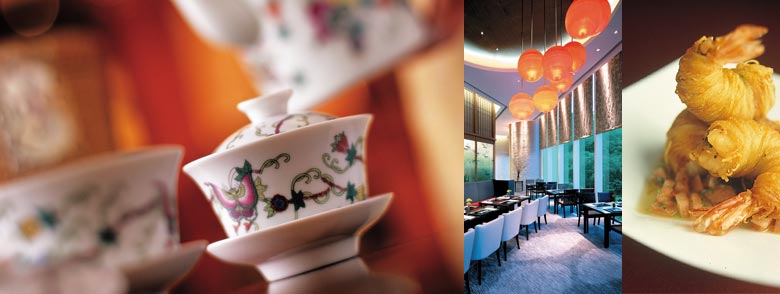 get to their fattest,
tastiest, and most roe-laden state, all the good ones go to the top
restaurants
in Shanghai and Hong Kong.
So
it took me about two sips of slightly
warmed Shaoxing Chiew--an oxidized 5-year old rice wine that smacks
of sherry crossed with a dash of Marsala--to decide on ordering the Hairy Crab Special Set, which doesn't sound
too appetizing, to be sure. This being China, such oddball and sometimes hilarious
translations
are to be expected, especially in a country where the words for street,
chicken
and prostitute (“gai”) are one
and the same. get to their fattest,
tastiest, and most roe-laden state, all the good ones go to the top
restaurants
in Shanghai and Hong Kong.
So
it took me about two sips of slightly
warmed Shaoxing Chiew--an oxidized 5-year old rice wine that smacks
of sherry crossed with a dash of Marsala--to decide on ordering the Hairy Crab Special Set, which doesn't sound
too appetizing, to be sure. This being China, such oddball and sometimes hilarious
translations
are to be expected, especially in a country where the words for street,
chicken
and prostitute (“gai”) are one
and the same.
The
repast began with a single, large Shanghainese pork dumpling dotted
with
coral-colored roe, followed by a haunting crab and smoke-flavored
shark’s fin
soup. I’m the first to admit there are
some flavor/texture profiles of Cantonese food that I just don’t get (like the obsession with dried
abalone and bird’s nest), but one sip of this extraordinary soup had me
appreciating the glass-like gelatinous threads that thickened the
strong stock
and provided a textural contrast to the uni-like crab fat roe that
floated
among them. Next came my lesson in
dissecting the hirsute little beast whose carapace was about the size
of my
fist. It took awhile to dismember
and
pluck the intensely sweet crab meat from the shell and legs, but the
lesson and
effort proved worth it as I eventually got to more yellow-gold fat
inside the
shell containing intense specks of even more roe. Of
the whole “set,” only the baked fried rice
with crabmeat missed the mark, as my western palate could discern none
of the
fatty crab flavor present in the other dishes.
The
staff, speaking broken English that easily trumped my two phrases of
Cantonese--“shea-shea” (thank
you) and “gan bei” (drink
up!)--instructed me to take small
sips of wine to accent but not overwhelm the flavors of the first two
courses. 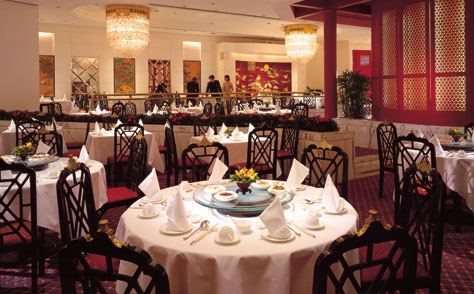 With the whole crab, they
gently coaxed me into sipping warm ginger tea to balance the cold
sensations of
the room-temperature crab I was taking from the shell.
“Like yin and yang?” I asked meekly, as they
nodded approvingly at my feeble effort to bridge our cultural divide. That tea had a chili-like heat and spiciness
to it and was unlike any I’ve ever had in any restaurant-Chinese or
otherwise.
Dessert
was likewise ginger-themed, with a warm “soup” of ginger juice in which
sat
melt-in-your-mouth sesame seed dumplings accompanied by the large,
spike-shaped
flower of Forever Marigold tea. I tend
to think of tea served in American-Chinese restaurants as a bad
joke--it
usually
being little more than vaguely flavored dark warm water. But Forever
Marigold,
like the ginger tea before it, had an aggressive character that played
off the
flavors of the dessert. And like the meal as a whole, these pronounced
sensations were a revelation, and belied Cantonese food’s reputation
for
lightness and subtlety. Some of those
flavors can still be vividly recalled, more than a month later, and are
among
many reasons I can’t wait to return With the whole crab, they
gently coaxed me into sipping warm ginger tea to balance the cold
sensations of
the room-temperature crab I was taking from the shell.
“Like yin and yang?” I asked meekly, as they
nodded approvingly at my feeble effort to bridge our cultural divide. That tea had a chili-like heat and spiciness
to it and was unlike any I’ve ever had in any restaurant-Chinese or
otherwise.
Dessert
was likewise ginger-themed, with a warm “soup” of ginger juice in which
sat
melt-in-your-mouth sesame seed dumplings accompanied by the large,
spike-shaped
flower of Forever Marigold tea. I tend
to think of tea served in American-Chinese restaurants as a bad
joke--it
usually
being little more than vaguely flavored dark warm water. But Forever
Marigold,
like the ginger tea before it, had an aggressive character that played
off the
flavors of the dessert. And like the meal as a whole, these pronounced
sensations were a revelation, and belied Cantonese food’s reputation
for
lightness and subtlety. Some of those
flavors can still be vividly recalled, more than a month later, and are
among
many reasons I can’t wait to return.
A few words about prices and etiquette. Compared to Western Europe and Japan,
prices are a relative bargain. Of course I
live and eat in Las Vegas, so everywhere
seems cheaper to me. Dim sum breakfasts
and lunches will run no more than $40 for two, unless you go hog wild. A four-course dinner at Yung Kee for two,
with a modest wine was around $120, and the six course, hairy crab
“Special
Set” came in at about a hundred dollars a person at an exchange rate of
$1.00
USD = 8 HKD. All restaurants add 10%
service charge to the check, and adding to that is appreciated, but not
expected by the wait staff. Paper
napkins, linens and shui, pronounced “schway”
(water) are easier to find at
more upscale places, although it was explained to me that potable water
was
only available on certain days of the week, well into the twentieth
century, so
the locals just aren’t familiar with our custom of quaffing large
amounts of
the stuff. And that’s why hot tea is so
ubiquitous.
Part
Three of this
three-part article will appear in three weeks.
~~~~~~~~~~~~~~~~~
Since
1995, John A.
Curtas has been commenting on the Las Vegas food scene and
reviewing restaurants for Nevada Public Radio. He is also the
restaurant critic for KLAS TV, Channel 8 in Las Vegas, and his past
reviews
can be accessed at KNPR.org.
~~~~~~~~~~~~~~~~~~~~~~~~~~~~~~~~~~~
NEW
YORK CORNER
by Mort Hochstein
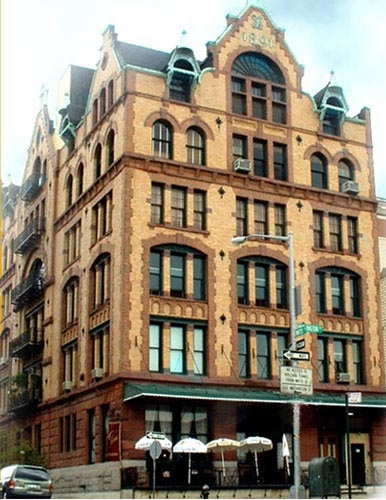 Capsouto
Frères Capsouto
Frères
491
Washington Street (at
Watts)
212 966 4900
www.capsoutofreres.com
There are several
places in Manhattan where I dine
often. Most are in the low price range, and usually near my
home. There are
only two among the more upscale that I return to with any frequency. One is San Domenico, serving truly expensive
and truly excellent Italian food. The
other is Capsouto Frères,
not
as expensive, not really a gourmet French
restaurant, but an upscale bistro that I turn to first when I think of
dining with good friends. I’ve been
going there since the early eighties and it is hard to believe that
this gem of
a restaurant, hidden away in an obscure corner of Manhattan, has been
around
for more than a quarter of a century.
The frères--brothers Jacques,
Albert and
Samuel—founded the place in 1980, locating in an old warehouse on an
untrafficked street, still hard to get to from anywhere. They were
starting up
in a true, low-rent district, violating the
ancient restaurant mantra of location, location,
location. Now, the highly gentrified
Tribeca, the area below Canal Street on
Manhattan’s
West Side is stretching north toward a
neighborhood the
Capsoutos once had pretty much all to
themselves. The once abandoned streets are sprouting upscale housing, restaurants and gourmet shops. Parking,
however, is still available, though slightly
more difficult.
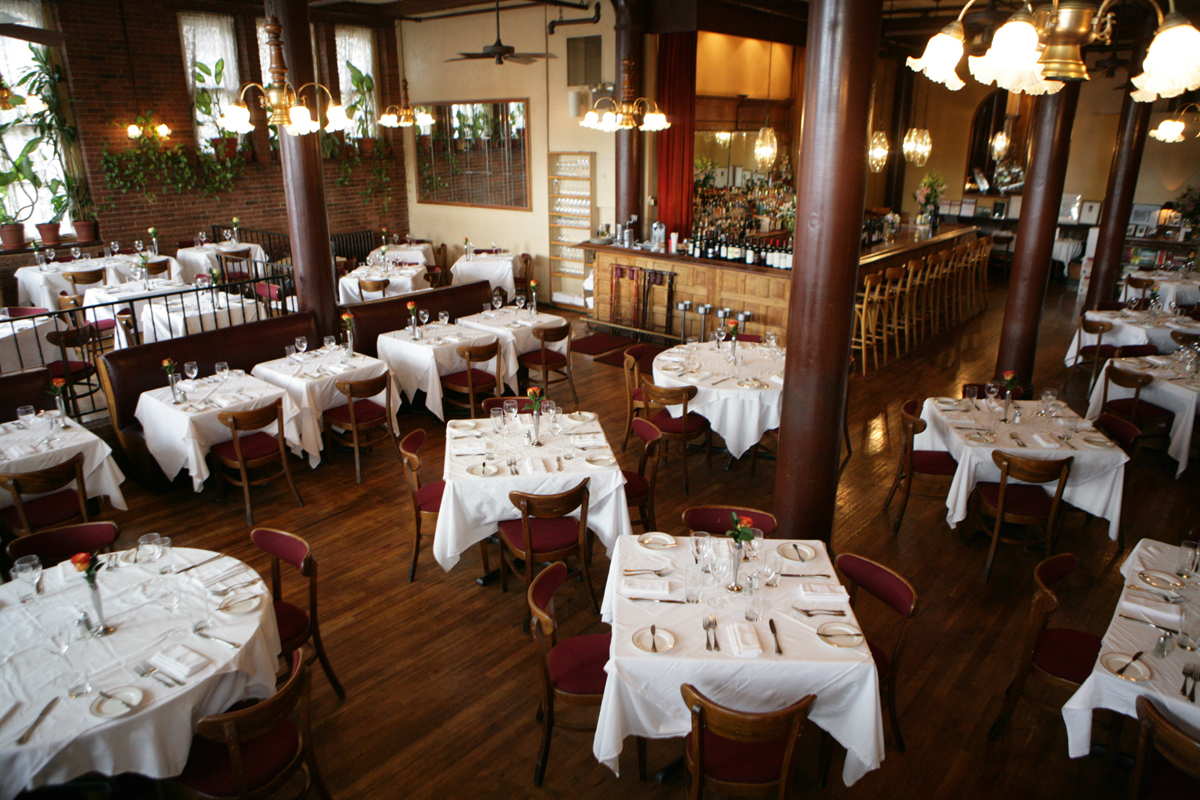 In crowded Manhattan, the peace and
spacious décor of Capsouto
Frères is a
joy. The room, with ceilings much higher than normal in Manhattan and
floor
space just as open, with antique brick walls and a comfortably
unobtrusive bar
at the front, is a pleasure to behold, nothing fancy, just plain easy
on the
senses and enjoyment is implied. The crowd, almost all regulars and a
shade
older than the wannabees populating trendy restaurants nearby, dine
quietly in
subdued satisfaction.
The
menu at Capsouto is based on a familiar
bistro lineup and trimmings the brothers
and chef Bennie Pittman have added. Escargots,
bouillabaisse, roasted duck, saucisson
chaud, and onion soup can be found
on many
bistro
menus now in the area, along with salade Niçoise, steak au
poivre, and sautéed
sweetbreads, but few places can
deliver them as impeccably night after night. Capsouto
serves feather-light
quenelles as
fine
as those in more expensive French
restaurants uptown, and few
can even
approximate the restaurant’s specialty--soufflés of varying
flavors such as
chocolate, raspberry or hazelnut or the chef’s special
on our last visit, tangerine with crème anglaise.
We
requested our soufflés immediately on
arrival that night, to insure they would
be available when dessert time came around. We’d started off ordering
four for
our table of five, but as our companions checked the full dessert menu
and
saw attractive options on the $39,
three-course prix-fixe menu, we cut our order to three. Two of us went for
the prix-fixe, selecting
a crisp arugula salad with goat cheese and a vegetable terrine,
Provençal
style, for starters. For mains, they
enjoyed the roasted duck, tangy with ginger and cassis sauce, and
orange
braised lamb shank.
My wife and I, anticipating those large
Capsouto entrees, elected to share an endive salad, with gorgonzola
dressing. My sweetbreads, accompanied by
a mushroom fricassée, always a favorite, were breaded a bit more
than I
prefer,
but otherwise flavorful. I mentioned it
to Sammy Capsouto, and he suggested that I specify light breading in
the
future. My wife went for
sole amandine
and my friends took the meunière,
and both were happy, although Rol’s had more
butter sauce than my dieting wife normally allows herself. In crowded Manhattan, the peace and
spacious décor of Capsouto
Frères is a
joy. The room, with ceilings much higher than normal in Manhattan and
floor
space just as open, with antique brick walls and a comfortably
unobtrusive bar
at the front, is a pleasure to behold, nothing fancy, just plain easy
on the
senses and enjoyment is implied. The crowd, almost all regulars and a
shade
older than the wannabees populating trendy restaurants nearby, dine
quietly in
subdued satisfaction.
The
menu at Capsouto is based on a familiar
bistro lineup and trimmings the brothers
and chef Bennie Pittman have added. Escargots,
bouillabaisse, roasted duck, saucisson
chaud, and onion soup can be found
on many
bistro
menus now in the area, along with salade Niçoise, steak au
poivre, and sautéed
sweetbreads, but few places can
deliver them as impeccably night after night. Capsouto
serves feather-light
quenelles as
fine
as those in more expensive French
restaurants uptown, and few
can even
approximate the restaurant’s specialty--soufflés of varying
flavors such as
chocolate, raspberry or hazelnut or the chef’s special
on our last visit, tangerine with crème anglaise.
We
requested our soufflés immediately on
arrival that night, to insure they would
be available when dessert time came around. We’d started off ordering
four for
our table of five, but as our companions checked the full dessert menu
and
saw attractive options on the $39,
three-course prix-fixe menu, we cut our order to three. Two of us went for
the prix-fixe, selecting
a crisp arugula salad with goat cheese and a vegetable terrine,
Provençal
style, for starters. For mains, they
enjoyed the roasted duck, tangy with ginger and cassis sauce, and
orange
braised lamb shank.
My wife and I, anticipating those large
Capsouto entrees, elected to share an endive salad, with gorgonzola
dressing. My sweetbreads, accompanied by
a mushroom fricassée, always a favorite, were breaded a bit more
than I
prefer,
but otherwise flavorful. I mentioned it
to Sammy Capsouto, and he suggested that I specify light breading in
the
future. My wife went for
sole amandine
and my friends took the meunière,
and both were happy, although Rol’s had more
butter sauce than my dieting wife normally allows herself.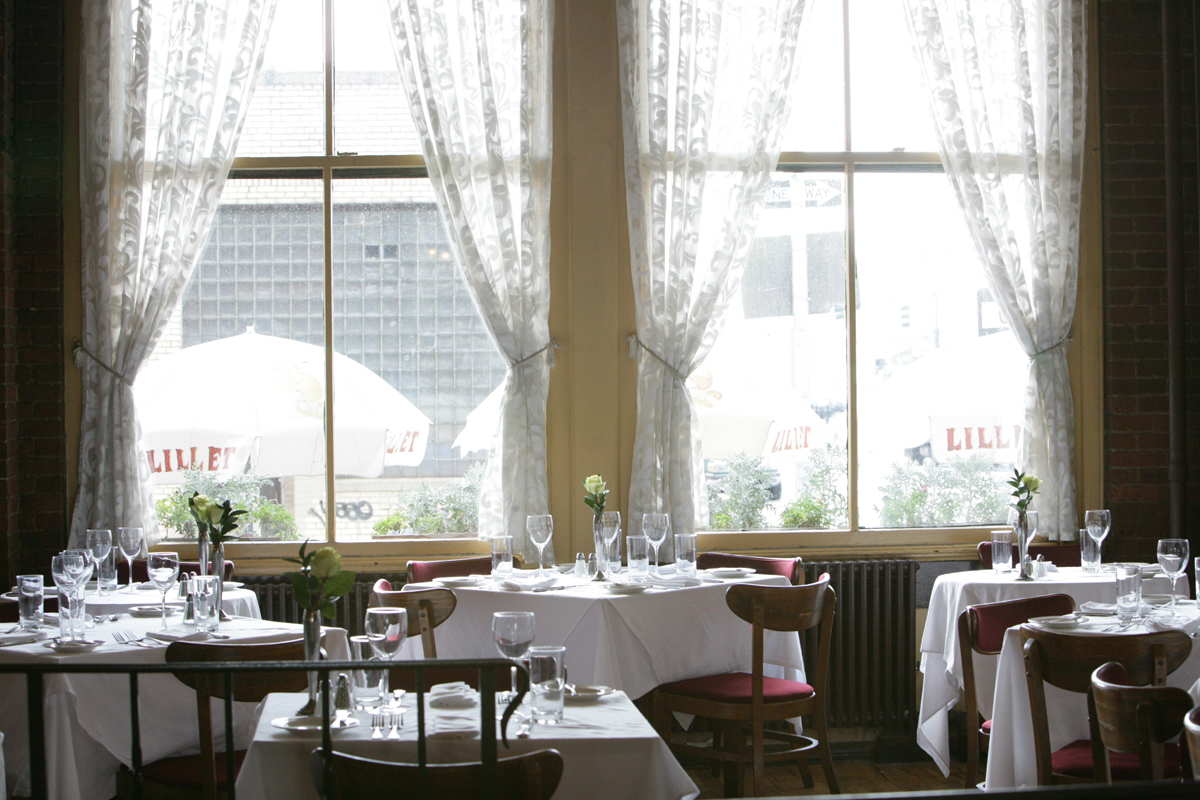 And then came those soufflés, three
towering poufs, one tangerine, one chocolate, one raspberry, each one
better
than the other and those plates went back completely empty. Our
companions
chose that bistro staple, apple tarte
Tatin, as well as another
Capsouto
specialty, blueberry crêpe.
And then came those soufflés, three
towering poufs, one tangerine, one chocolate, one raspberry, each one
better
than the other and those plates went back completely empty. Our
companions
chose that bistro staple, apple tarte
Tatin, as well as another
Capsouto
specialty, blueberry crêpe.
The wine list reflects Jacques' special
interests, with about
150 reasonably prices bottles, many under $40, many
from small wineries in California, France and Spain where he has
visited and made personal selections. As an
unofficial ambassador for Israel’s booming
wine industry, he carries more wines from
that region than any non-kosher restaurant in the city. He is also a Beaujolais
advocate.
Cheers to
the three brothers for nearly three
decades of satisfying New Yorkers. As leaders in the Tribeca community,
they
worked almost non-stop after
the 9/11
attacks, providing neighbors, firefighters, rescue workers, police
officers and
others with free meals and a place to rest. Their annual Passover
seders,
raising money for a different charity each year, sell out
within days of being announced and we’ve been
lucky to attend two of them. And a
special nod to Jacques, now a spokesman for Israeli wines, and also the
heavily
French-accented voice for his
restaurant’s humorous commercials, a
staple for years in New York on WQXR and now on WOR.
Capsouto Frères is open for dinner daily.
Lunch Tues.-Sun. Brunch, Sat. & Sun. Prix-fixe 3-course menu
is $39. à la carte appetizers $8.50
to $18 and main courses from $18 to $32.
~~~~~~~~~~~~~~~~~~
Mort
Hochstein, former editor and producer for NBC News and the Today Show,
and former managing editor of Nation's
Restaurant News, writes on wine,
food and travel for Wine Spectator, Wine Business Monthly, Saveur
and other food and wine publications.
~~~~~~~~~~~~~~~~~~~~~~~~~~~~~~~~~~~~~~~~~~
NOTES
FROM THE WINE CELLAR
Meritage
Celebrates 20th Anniversary
with 201st Member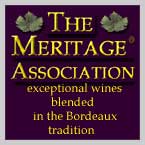
by John Mariani
It
is difficult to
imagine a time when California winemakers
scoffed at
the idea of blending their big, tannic cabernet sauvignons with less
prestigious grapes. Back in the 1970s
and 1980s heavily oaked “blockbuster cabs” that could “blow your doors
off”
were routine, and the California style was
built on
those very wines.
Then, in 1988, a group
of California
wineries, led by Agustin Huneeus (below)
of Franciscan (now with Quintessa), Julie
Garvey of Flora Springs, and Mitch Cosentino of Cosentino, got together
to form
an association that would allow them to blend their cabs with
traditional
Bordeaux varietals like merlot, cabernet franc, petit verdot, malbec,
gros
verdot, and carmenère in any percentages they chose. After
holding a
contest that
received 6,000 entries to come up with a name for the new association,
they
chose “Meritage,” a cognate of “merit” and “heritage,” pronounced like
“heritage.”
 The problem was, if the wineries bucked
the federal wine regulation that a wine labeled cabernet had to be at
least 75
percent cabernet, it would be allowed only the lowest-class label of
“table
wine.”
“Bordeaux was the
fundamental
model for cabernet wines,” explains Michaela K. Rodeno (below) of St. Supéry winery
and
from 1999 until this year chairperson of the Meritage Association.
“I asked the
members three times if they wanted to allow other 10 percent of
non-Bordeaux grapes
in the blend, and three times they said no.” (A white Meritage is made
from a Bordeaux blend of two
or more varieties
that include sauvignon blanc, semillon, and sauvignon vert.) The problem was, if the wineries bucked
the federal wine regulation that a wine labeled cabernet had to be at
least 75
percent cabernet, it would be allowed only the lowest-class label of
“table
wine.”
“Bordeaux was the
fundamental
model for cabernet wines,” explains Michaela K. Rodeno (below) of St. Supéry winery
and
from 1999 until this year chairperson of the Meritage Association.
“I asked the
members three times if they wanted to allow other 10 percent of
non-Bordeaux grapes
in the blend, and three times they said no.” (A white Meritage is made
from a Bordeaux blend of two
or more varieties
that include sauvignon blanc, semillon, and sauvignon vert.)
Despite acquiring a trademark for the
name Meritage and charging only a small annual fee-$1 a case with a cap
at $500—to
join the Association, many wineries that believed in blending still
didn’t see
much reason to join the organization, because their wines would only
carry the
words “red table wine”; they also worried that consumers would think
Meritage
was the name of a wine. After ten years the Association still had only
22
members, even though many, like Dry Creek and Franciscan had earned
reputations
as among the finest American red wines.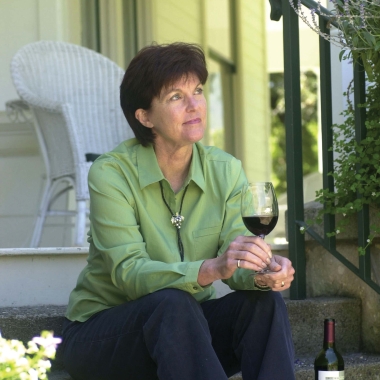
When Rodeno and her co-chair (since 2006)
Julie Weinstock of Cosentino came aboard, they found a dormant
Association
that had put too much stress merely on getting recognition from the
Bureau of
Tobacco and Firearms, which never happened. “We decided then to revise
our
plans in order to do more education and marketing, tastings, charity
events,
and auctions,” Rodeno told me in an interview while visiting New York. The
Association donated
to auctions at the High Museum of Art Atlanta, and WGBH Boston, and it
was
considered a coup when the very picky Napa Valley Vintners Wine Auction
accepted
Meritage lots. Increasingly the wines gained access to prestigious
international exhibitions like Italy’s VinItaly. The Association also works with Women for
WineSense, which holds extensive tastings and educational programs
throughout
the U.S.
The
result is that now, on its
20th
anniversary, the Association has 201 members from 20 states, Argentina,
Australia, Israel, Mexico, and its latest member, from France. Among its U.S. members it counts some of the
biggest names in California, like Clos LaChance, Davis Bynum, Dry
Creek, Gallo of Sonoma, Kendall-Jackson,
Rosenblum Cellars, Sequoia Grove, and St. Francis. Still, there are
some prominent
hold-outs, including Opus One and Dominus.
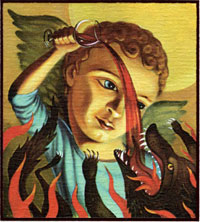 Even now Meritage
wines cannot put a
varietal name on the label, nor even “Bordeaux blend,” though they may
list the
blend’s varieties on the back label. Most members have quietly dropped
“table”
from “red table wine.” St. Supery’s award-winning Élu (label icon at left), a wonderfully
lush blend
of cabernet sauvignon, merlot, petit verdot, 2% cabernet
franc, and Malbec, is labeled only as “Napa Valley Red Wine.” It costs
about $65. Even now Meritage
wines cannot put a
varietal name on the label, nor even “Bordeaux blend,” though they may
list the
blend’s varieties on the back label. Most members have quietly dropped
“table”
from “red table wine.” St. Supery’s award-winning Élu (label icon at left), a wonderfully
lush blend
of cabernet sauvignon, merlot, petit verdot, 2% cabernet
franc, and Malbec, is labeled only as “Napa Valley Red Wine.” It costs
about $65.
Perhaps most important
to Meritage
achieving clout after two decades is that the name has been largely
embraced by
U.S. restaurateurs, who now give Meritage wines a section separate on
their
winelists, right next to cabernet.
Now that the battles
have been won for
recognition, what are the goals for Meritage in the next 20 years? “I
think
we’ve established a corral of wines with different styles and prices
for the
benefit of consumers,” says Rodeno. “And with the under-30
`Millennials’
drinking more wine, we’ve got a whole new audience that’s really
craving
something out of the ordinary.”
John
Mariani's weekly wine column appears in Bloomberg Muse News,
from which this story was adapted. Bloomberg News covers Culture from
art, books, and theater to wine, travel, and food on a daily basis, and
some of its articles play of the Saturday Bloomberg Radio and TV.
~~~~~~~~~~~~~~~~~~~~~~~~~~
Police
Collected All of the Evidence Then Ate It
In Madison, WI, Warren
Whitelighting led police on a high-speed chase
after stealing a Krispy Kreme donut truck. He was
charged with shoplifting eight giant red hot pickled sausages from the
Open
Pantry on University Avenue, stealing the donut truck, ramming a
University of
Wisconsin Police car, attempting to elude pursing officers, operating
after
revocation, drunk driving (fourth time), and a hit-and-run. You may
view the chase, complete with donuts flying out of the truck at: http://snafu-ed.blogspot.com/2007/12/police-chase-down-perp-in-krispy-kreme.html
.
. . . . Around the same time in
Richland, WA, another thief stole a doughtut truck from Viera's Bakery.
An all-points bulletin was sent out and, after a 35 mph chase, Steve
Swoboda, 19, was arrested on charges of auto theft and felony
escape. Unlike the incident in Madison, the pilfered donuts were
still
intact.
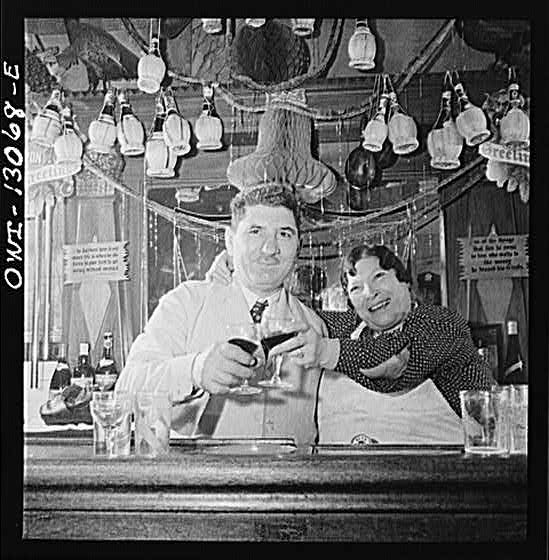
OR
LIKE BELUGA CAVIAR AND CHOCOLATE SYRUP
"While
Mimi sets the tone in
the dining
room, her husband runs the kitchen with an innovative sense that has
made him Houston's most acclaimed chef. The pair complement
each other
like ... well, dark roasted tomato salsa and fennel seed crema."--Dai
Huynh, "Getting a New Grove," Houston
Chronicle (Jan. 6, 2008).
QUICK
BYTES
To
all public relations people: Owing to the amount of press releases
regarding Valentine's Day dinners, I regret that it is impossible to
list any but very special events.
* On Feb
5 in Highwood,
IL, Gabriel’s Restaurant continues
its monthly wine series, with Chef Gabriel Viti and Sommelier Bob
Bansberg
presenting “TheWines and Cuisine of Bordeaux” for a 5-course dinner at
$125.
Call 847-433-0031; visit www.egabriels.com
* On Feb. 5 ZYR Russian Vodka
and Chef Dave Spano of
Red Square host Atlantic City's first 5-course Vodka Maker's Dinner with
Dave Katz, creator of ZYR, and Chef Dave
Strano. Call 609-344-9100; www.chinagrillmgt.com.
* On Feb. 7 at Currant American
Brasserie in San Diego, Chef Jonathan Pflueger welcomes chef Wayne
Nish to
create a 7-course menu at Currant American Brasserie. $90
pp with $50 wine supplement. Call 619-702-6309.
* On Feb. 7 in Washington, D.C., Roof Terrace Restaurant is celebrating he
Japanese culture during the Kennedy Center’s “Japan! culture + hyper
culture festival,”
with guest chef Makoto Takamura of Ni Fu Rin restaurant.
$125 pp. Roof
Terrace will also be serving a prix-fixe Japanese inspired menu by Chef
de
Cuisine Karen Hayes and Pastry Chef Bruce Connell. $60 pp.
The less formal KC Café is offering Japanese
inspired specials for both lunch and dinner. Visit
www.roofterracerestaurant.com
or call 202-416-8555.
*
On Feb. 8 in Greenville, SC, Restaurant
O is hosting a 5-course foie gras dinner by chef Jesse
Thompson. $70 pp, $100 with wine. Call 864-331-0007; www.restauranto.com
* On Feb. 9
at Rialto in Cambridge, MA, Chef-owner
Jody Adams will demonstrate a "The
Prince and the Pauper" 3-course dinner, pairing elegant and interesting
sparkling wines with deliciously rustic food from the region of Puglia,
followed by the meal and wine. $125 pp. Call 617-661-5050.
*
On Feb. 20 La Samanna
on St. Martin will hold “La Soirée des Chefs Act
IV,” a 5-course
dinner with wine pairings, with Chef Daniel Echasseriau and John Jordan of Jordan wineries. $200 pp. Dining in the wine
cellar, La
Cave, available for 4-8 people at $300 pp. . . . “Gastronomic Week Act
II” is a
5-day culinary event from June 18-22, with dinners
by chefs from 5 properties worldwide,
incl. Raymond Blanc from the Le Manoir aux Quat' Saisons in
Oxfordshire,
with wines from Château de Beaucastel; Francesco Carli, from Copacabana
Palace in Rio De Janeiro, with Marques De Caceres; Daniel
Echasseriau from La Samanna with
Domaine Louis Jadot ; John Greeley from `21’
Club with Tablas Creek Vineyard; Wilo Benet from Pikayo in
San Juan
with Pio Cesare. Visit www.lasamanna.com
or call 800-854-2252.
*
On Feb.
26 in San Francisco, The Campton Place will
hold a wine dinner with Dr. J. Bernard Seps, Founder
& Owner of Storybook Mountain Vineyards in Napa Valley,
focusing on the question of ageability of Zinfandel. Chef
Gavin Schmidt. $160 pp. Call 415-955-5574.
* On Feb. 27 at NYC’s PIER
SIXTY at Chelsea Piers, Chef Marcus Samuelsson of Aquavit,
Riingo, and Merkato 55 restaurants, will help orchestrate a grand
walk-around-tasting prepared by top
chefs assisted by high school students to benefit the Careers through
Culinary
Arts Program (C-CAP). Also, a silent auction with over 30
items. TV’sAl Roker will be MC. This year’s honoree is Alfred Portale,
Executive Chef at Gotham Bar
and Grill. $450 pp; VIP are $600 and $1,000. Call 212-974-7111or visit www.ccapinc.org.
NEW
FEATURE: I am happy to report that the Virtual Gourmet is linking up
with two excellent travel sites:
Everett
Potter's
Travel Report:
I
consider this the best
and savviest blog of its kind on the web. Potter is a columnist
for USA Weekend, Diversion, Laptop and
Luxury Spa Finder,
a contributing editor for Ski
and a frequent contributor to National
Geographic Traveler, ForbesTraveler.com and Elle Decor. "I’ve designed this
site is for people who take their travel seriously," says Potter.
"For travelers who want to learn about special places but don’t
necessarily want to pay through the nose for the privilege of
staying there. Because at the end of the day, it’s not so much about
five-star places as five-star experiences." THIS
WEEK: HIGH
ANXIETY: An acrophobe goes rappelling in Belize.
Tennis Resorts Online:
A Critical Guide to the World's
Best Tennis Resorts and Tennis Camps,
published by ROGER COX, who has spent more than two decades writing
about tennis travel, including a 17-year stretch for Tennis magazine. He has also
written for Arthur Frommer's Budget
Travel, New York Magazine,
Travel & Leisure, Esquire, Money, USTA Magazine, Men's Journal, and The Robb Report. He has
authored two books-The World's
Best Tennis Vacations (Stephen Greene Press/Viking Penguin,
1990) and The Best Places to Stay in the Rockies (Houghton
Mifflin, 1992 & 1994), and the Melbourne (Australia) chapter to the
Wall Street Journal Business
Guide to Cities of the
Pacific Rim (Fodor's Travel Guides, 1991). Click on the logo
below to go to the site.
~~~~~~~~~~~~~~~~~~~~~~~~~~~~~~~~~~~~~~~~~~~~~~~~~~~~~~~~~~~~~~~~~~~~~~~~~
MARIANI'S VIRTUAL GOURMET NEWSLETTER is published weekly. Editor/Publisher: John Mariani.
Contributing Writers: Robert Mariani,
Naomi
Kooker, Suzanne Wright, John A. Curtas, Edward Brivio, Mort
Hochstein, Suzanne Wright. Contributing
Photographers: Galina Stepanoff-Dargery, Bobby Pirillo. Technical
Advisor: Gerry McLoughlin.
John Mariani is a columnist for Esquire, Wine Spectator, Bloomberg News and
Radio, and Diversion.
He is author of The Encyclopedia
of American Food & Drink (Lebhar-Friedman), The Dictionary
of Italian Food and Drink (Broadway), and, with his wife Galina, the
award-winning Italian-American Cookbook (Harvard Common
Press).
Any of John Mariani's books below
may be ordered from amazon.com by clicking on the cover image.
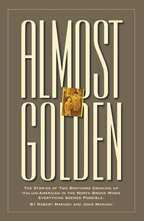 My
newest book, written with my brother Robert Mariani, is a memoir of our
years growing up in the North
Bronx. It's called Almost
Golden because it re-visits an idyllic place and time in our
lives when
so many wonderful things seemed possible. My
newest book, written with my brother Robert Mariani, is a memoir of our
years growing up in the North
Bronx. It's called Almost
Golden because it re-visits an idyllic place and time in our
lives when
so many wonderful things seemed possible.
For those of you who don't think
of
the Bronx as “idyllic,” this
book will be a revelation. It’s
about a place called the Country Club area, on the shores of Pelham Bay. It was a beautiful
neighborhood filled with great friends
and wonderful adventures that helped shape our lives.
It's about a culture, still vibrant, and a place that is still almost
the same as when we grew up there.
Robert and I think you'll enjoy this
very personal look at our Bronx childhood. It is not
yet available in bookstores, so to purchase
a copy, go to amazon.com
or click on Almost Golden.
--John
Mariani
|
copyright John Mariani 2008
|
|


 Yung
Kee has been celebrating the cult of the splayed goose since the
1950’s, and
there’s no doubt what to order once you pass the front window, where
chefs
slice, flatten and prepare them on thick round chopping blocks on their
way to
the roasting ovens. It is also famous
for the luminescent purple-green yolks and amber colored whites of its
1,000-year old eggs (below). These pungent,
sulfuric delicacies are really closer to 100 days old, having been
submersed in
lime, ashes and salt for about that long. Accompanied
by fresh pickled ginger, they clear the palate
and the head
for the rich and fatty goose yet to come.
Yung
Kee has been celebrating the cult of the splayed goose since the
1950’s, and
there’s no doubt what to order once you pass the front window, where
chefs
slice, flatten and prepare them on thick round chopping blocks on their
way to
the roasting ovens. It is also famous
for the luminescent purple-green yolks and amber colored whites of its
1,000-year old eggs (below). These pungent,
sulfuric delicacies are really closer to 100 days old, having been
submersed in
lime, ashes and salt for about that long. Accompanied
by fresh pickled ginger, they clear the palate
and the head
for the rich and fatty goose yet to come.
 get to their fattest,
tastiest, and most roe-laden state, all the good ones go to the top
restaurants
in
get to their fattest,
tastiest, and most roe-laden state, all the good ones go to the top
restaurants
in  With the whole crab, they
gently coaxed me into sipping warm ginger tea to balance the cold
sensations of
the room-temperature crab I was taking from the shell.
“Like yin and yang?” I asked meekly, as they
nodded approvingly at my feeble effort to bridge our cultural divide. That tea had a chili-like heat and spiciness
to it and was unlike any I’ve ever had in any restaurant-Chinese or
otherwise.
With the whole crab, they
gently coaxed me into sipping warm ginger tea to balance the cold
sensations of
the room-temperature crab I was taking from the shell.
“Like yin and yang?” I asked meekly, as they
nodded approvingly at my feeble effort to bridge our cultural divide. That tea had a chili-like heat and spiciness
to it and was unlike any I’ve ever had in any restaurant-Chinese or
otherwise. Capsouto
Frères
Capsouto
Frères  In crowded Manhattan, the peace and
spacious décor of Capsouto
Frères is a
joy. The room, with ceilings much higher than normal in Manhattan and
floor
space just as open, with antique brick walls and a comfortably
unobtrusive bar
at the front, is a pleasure to behold, nothing fancy, just plain easy
on the
senses and enjoyment is implied. The crowd, almost all regulars and a
shade
older than the wannabees populating trendy restaurants nearby, dine
quietly in
subdued satisfaction.
In crowded Manhattan, the peace and
spacious décor of Capsouto
Frères is a
joy. The room, with ceilings much higher than normal in Manhattan and
floor
space just as open, with antique brick walls and a comfortably
unobtrusive bar
at the front, is a pleasure to behold, nothing fancy, just plain easy
on the
senses and enjoyment is implied. The crowd, almost all regulars and a
shade
older than the wannabees populating trendy restaurants nearby, dine
quietly in
subdued satisfaction.

 The problem was, if the wineries bucked
the federal wine regulation that a wine labeled cabernet had to be at
least 75
percent cabernet, it would be allowed only the lowest-class label of
“table
wine.”
“
The problem was, if the wineries bucked
the federal wine regulation that a wine labeled cabernet had to be at
least 75
percent cabernet, it would be allowed only the lowest-class label of
“table
wine.”
“
 Even now Meritage
wines cannot put a
varietal name on the label, nor even “Bordeaux blend,” though they may
list the
blend’s varieties on the back label. Most members have quietly dropped
“table”
from “red table wine.” St. Supery’s award-winning Élu (label icon at left), a wonderfully
lush blend
of cabernet sauvignon, merlot, petit verdot, 2% cabernet
franc, and Malbec, is labeled only as “Napa Valley Red Wine.” It costs
about $65.
Even now Meritage
wines cannot put a
varietal name on the label, nor even “Bordeaux blend,” though they may
list the
blend’s varieties on the back label. Most members have quietly dropped
“table”
from “red table wine.” St. Supery’s award-winning Élu (label icon at left), a wonderfully
lush blend
of cabernet sauvignon, merlot, petit verdot, 2% cabernet
franc, and Malbec, is labeled only as “Napa Valley Red Wine.” It costs
about $65.

 My
newest book, written with my brother Robert Mariani, is a memoir of our
years growing up in the
My
newest book, written with my brother Robert Mariani, is a memoir of our
years growing up in the 






